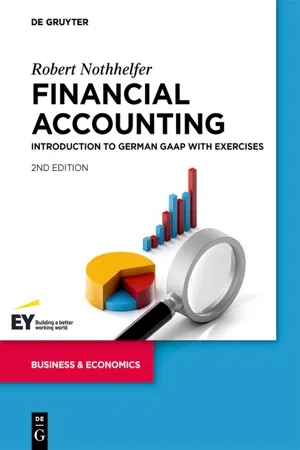
Financial Accounting
Introduction to German GAAP with exercises
Robert Nothhelfer
- 421 pages
- English
- ePUB (mobile friendly)
- Available on iOS & Android
Financial Accounting
Introduction to German GAAP with exercises
Robert Nothhelfer
About This Book
Every German student of business administration needs to have a basic understanding of accounting according to German GAAP. Thanks to globalization, many courses in German accounting are nowadays conducted in English. In addition, many foreign subsidiaries of German companies have to prepare their part of consolidated financial statements according to German GAAP. So far students taking these accounting courses and professionals preparing these financial statements have had to rely on German literature only and did not have an English textbook to refer to that covers German GAAP accounting topics in detail.
To fill this gap, the first edition of this book offered a compact introduction to financial statements according to German GAAP, and exercises on individual topics with solutions and case studies for in-depth and effective learning. The revised and extended second edition with updated references and text, adds a complete translation of the parts of the German Commercial Code that are directly relevant for accounting. Students and professionals can now go back to the original source when working out accounting problems. It provides ideal support for German-speaking students and is furthermore valuable for professionals looking for explanations when preparing the data for consolidated financial statements.
- Includes exercises and case studies for practice
- Ideal textbook for students of German universities attending English-speaking lectures in financial management
- Ideal introduction for professionals with succinct explanations and additional support in the form of a glossary and list of vocabulary terms
Frequently asked questions
Information
Part I: Financial statements according to German GAAP
1 Introduction to accounting
1.1 Purpose of accounting
1.1.1 The fundamental question and the fundamental equation
| Cash at the beginning | 10,000 |
| − purchases in cash | − 4,000 |
| − current expenses | − 8,000 |
| + cash from services | 24,000 |
| = cash at end | 22,000 |
| + purchased assets | 6,000 |
| = total assets | 28,000 |
Table of contents
- Title Page
- Copyright
- Contents
- Abbreviations
- Part I: Financial statements according to German GAAP
- Part II: Exercises The following exercises are mainly fromNothhelfer/Bacher/Rade/Scholz, Klausurtraining für Bilanzierung und Finanzwirtschaft, 1st edition, De Gruyter Oldenbourg, Berlin, 2015
- Part III: Additional information
- 9 Glossary
- 10 Vocabulary
- Index